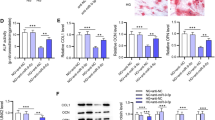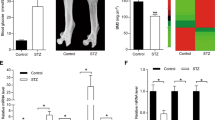Abstract
Diabetic osteoporosis is a severe and chronic complication of diabetes in the bone and joint system, and its pathogenesis is needed to be explored. In the present study, we examined the effect and underlying mechanism of miR-155 on osteogenic differentiation in human bone marrow–derived mesenchymal stem cells (hBMSCs) under high glucose and free fatty acids (HG-FFA) conditions. It was shown that miR-155 levels in hBMSCs increased corresponding to the time of exposure to HG-FFA treatment. MiR-155 expression was altered by transfecting miR-155 mimic or miR-155 inhibitor. HG-FFA exposure resulted in an obviously decrease in cell viability and alkaline phosphatase (ALP) activity, and downregulated the expressionof runt-related transcription factor 2 (Runx2) and osteocalcin (OCN) in hBMSCs. Transfection of miR-155 mimic further exacerbated HG-FFA-induced inhibitory effect on osteogenic differentiation, and miR-155 inhibitor neutralized this inhibitory effect. Luciferase assays confirmed that SIRT1 was a direct target of miR-155 and can be negatively modulated by miR-155. Furthermore, SIRT1 siRNA partially counteracted miR-155 inhibitor–induced upregulation of SIRT1in HG-FFA-treated hBMSCs. SIRT1 siRNA also reversed the promotional effect of the miR-155 inhibitor on ALP activity and expression of the Runx2 and OCN proteins under HG-FFA conditions. In conclusion, the results suggest that miR-155 suppression promoted osteogenic differentiation of hBMSCs under HG-FFA conditions by targeting SIRT1. Inhibition of MiR-155 may provide a new therapeutic method for the prevention and treatment of diabetic osteoporosis.




Similar content being viewed by others
References
Asgharzadeh A, Alizadeh S, Keramati MR, Soleimani M, Atashi A, Edalati M, Kashani Khatib Z, Rafiee M, Barzegar M, Razavi H (2018) Upregulation of miR-210 promotes differentiation of mesenchymal stem cells (MSCs) into osteoblasts. Bosn J Basic Med Sci 18:328–335. https://doi.org/10.17305/bjbms.2018.2633
Cao B, Liu N, Wang W (2016) High glucose prevents osteogenic differentiation of mesenchymal stem cells via lncRNA AK028326/CXCL13 pathway. Biomed Pharmacother 84:544–551. https://doi.org/10.1016/j.biopha.2016.09.058
Chen H, Liu X, Chen H, Cao J, Zhang L, Hu X, Wang J (2014) Role of SIRT1 and AMPK in mesenchymal stem cells differentiation. Ageing Res Rev 13:55–64. https://doi.org/10.1016/j.arr.2013.12.002
Chen Y, Hu Y, Yang L, Zhou J, Tang Y, Zheng L, Qin P (2017) Runx2 alleviates high glucose-suppressed osteogenic differentiation via PI3K/AKT/GSK3beta/beta-catenin pathway. Cell Biol Int 41:822–832. https://doi.org/10.1002/cbin.10779
Gong K, Qu B, Wang C, Zhou J, Liao D, Zheng W, Pan X (2017) Peroxisome proliferator-activated receptor alpha facilitates osteogenic differentiation in MC3T3-E1 cells via the Sirtuin 1-dependent signaling pathway. Mol Cells 40:393–400. https://doi.org/10.14348/molcells.2017.0018
Gopalakrishnan V, Vignesh RC, Arunakaran J, Aruldhas MM, Srinivasan N (2006) Effects of glucose and its modulation by insulin and estradiol on BMSC differentiation into osteoblastic lineages. Biochem Cell Biol 84:93–101. https://doi.org/10.1139/o05-163
Gu Y, Ma L, Song L, Li X, Chen D, Bai X (2017) miR-155 inhibits mouse osteoblast differentiation by suppressing SMAD5 expression. Biomed Res Int 2017, 1893520. https://doi.org/10.1155/2017/1893520
Hu L, Yin C, Zhao F, Ali A, Ma J, Qian A (2018) Mesenchymal stem cells: cell fate decision to osteoblast or adipocyte and application in osteoporosis treatment. Int J Mol Sci 19. https://doi.org/10.3390/ijms19020360
Huang C, Geng J, Jiang S (2017) MicroRNAs in regulation of osteogenic differentiation of mesenchymal stem cells. Cell Tissue Res 368:229–238. https://doi.org/10.1007/s00441-016-2462-2
Kemink SA, Hermus AR, Swinkels LM, Lutterman JA, Smals AG (2000) Osteopenia in insulin-dependent diabetes mellitus; prevalence and aspects of pathophysiology. J Endocrinol Investig 23:295–303. https://doi.org/10.1007/BF03343726
Li B, Wang Y, Liu Y, Ma J, Li Y (2013) Altered gene expression involved in insulin signaling pathway in type II diabetic osteoporosis rats model. Endocrine 43:136–146. https://doi.org/10.1007/s12020-012-9757-1
Liu H, Zhong L, Yuan T, Chen S, Zhou Y, An L, Guo Y, Fan M, Li Y, Sun Y, Li W, Shi Q, Weng Y (2018) MicroRNA-155 inhibits the osteogenic differentiation of mesenchymal stem cells induced by BMP9 via downregulation of BMP signaling pathway. Int J Mol Med 41:3379–3393. https://doi.org/10.3892/ijmm.2018.3526
Liu M, Lu Y, Cheng X, Ma L, Miao X, Li N, Sun B, Yan S, Li J, Li C (2019) Relationship between abnormal glucose metabolism and osteoporosis in Han Chinese men over the age of 50 years. Clin Interv Aging 14:445–451. https://doi.org/10.2147/CIA.S164021
Polina ER, Oliveira FM, Sbruzzi RC, Crispim D, Canani LH, Santos KG (2019) Gene polymorphism and plasma levels of miR-155 in diabetic retinopathy. Endocr Connect. https://doi.org/10.1530/EC-19-0446
Qu B, Gong K, Yang HS, Li YG, Jiang T, Zeng ZM, Cao ZR, Pan XM (2018) MiR-449 overexpression inhibits osteogenic differentiation of bone marrow mesenchymal stem cells via suppressing Sirt1/Fra-1 pathway in high glucose and free fatty acids microenvironment. Biochem Biophys Res Commun 496:120–126. https://doi.org/10.1016/j.bbrc.2018.01.009
Strycharz J, Rygielska Z, Swiderska E, Drzewoski J, Szemraj J, Szmigiero L, Sliwinska A (2018) SIRT1 as a therapeutic target in diabetic complications. Curr Med Chem 25:1002–1035. https://doi.org/10.2174/0929867324666171107103114
Wang J, Wang B, Li Y, Wang D, Lingling E, Bai Y, Liu H (2013) High glucose inhibits osteogenic differentiation through the BMP signaling pathway in bone mesenchymal stem cells in mice. EXCLI J 12:584–597
Wang P, Wang Y, Tang W, Wang X, Pang Y, Yang S, Wei Y, Gao H, Wang D, Cao Z (2017) Bone morphogenetic protein-9 enhances osteogenic differentiation of human periodontal ligament stem cells via the JNK pathway. PLoS One 12:e0169123. https://doi.org/10.1371/journal.pone.0169123
Wang Q, Li Y, Zhang Y, Ma L, Lin L, Meng J, Jiang L, Wang L, Zhou P, Zhang Y (2017) LncRNA MEG3 inhibited osteogenic differentiation of bone marrow mesenchymal stem cells from postmenopausal osteoporosis by targeting miR-133a-3p. Biomed Pharmacother 89:1178–1186. https://doi.org/10.1016/j.biopha.2017.02.090
Wang W, Chen J, Hui Y, Huang M, Yuan P (2018) Down-regulation of miR-193a-3p promotes osteoblast differentiation through up-regulation of LGR4/ATF4 signaling. Biochem Biophys Res Commun 503:2186–2193. https://doi.org/10.1016/j.bbrc.2018.08.011
Yang X, Huo F, Liu B, Liu J, Chen T, Li J, Zhu Z, Lv B (2017) Crocin inhibits oxidative stress and pro-inflammatory response of microglial cells associated with diabetic retinopathy through the activation of PI3K/Akt signaling pathway. J Mol Neurosci 61:581–589. https://doi.org/10.1007/s12031-017-0899-8
Yao W, Lane NE (2015) Targeted delivery of mesenchymal stem cells to the bone. Bone 70:62–65. https://doi.org/10.1016/j.bone.2014.07.026
Yoon DS, Choi Y, Lee JW (2016) Cellular localization of NRF2 determines the self-renewal and osteogenic differentiation potential of human MSCs via the P53-SIRT1 axis. Cell Death Dis 7:e2093. https://doi.org/10.1038/cddis.2016.3
Zaidi SK, Sullivan AJ, van Wijnen AJ, Stein JL, Stein GS, Lian JB (2002) Integration of Runx and Smad regulatory signals at transcriptionally active subnuclear sites. Proc Natl Acad Sci U S A 99:8048–8053. https://doi.org/10.1073/pnas.112664499
Zainabadi K, Liu CJ, Guarente L (2017) SIRT1 is a positive regulator of the master osteoblast transcription factor, RUNX2. PLoS One 12:e0178520. https://doi.org/10.1371/journal.pone.0178520
Zhang D, Cui Y, Li B, Luo X, Li B, Tang Y (2016) miR-155 regulates high glucose-induced cardiac fibrosis via the TGF-beta signaling pathway. Mol BioSyst 13:215–224. https://doi.org/10.1039/c6mb00649c
Ziros PG, Basdra EK, Papavassiliou AG (2008) Runx2: of bone and stretch. Int J Biochem Cell Biol 40:1659–1663. https://doi.org/10.1016/j.biocel.2007.05.024
Author information
Authors and Affiliations
Corresponding author
Ethics declarations
Conflict of interest
The authors declare that there are no conflicts of interest.
Additional information
Publisher’s note
Springer Nature remains neutral with regard to jurisdictional claims in published maps and institutional affiliations.
Highlights
• MiR-155 was upregulated in HG-FFA conditions during osteogenic differentiation.
• MiR-155 inhibited the osteogenic differentiation of hBMSCs in HG-FFA conditions.
• SIRT1 was a direct target of miR-155.
• SIRT1 silence reversed miR-155 inhibitors-induced osteogenic differentiation in HG-FFA-treated hBMSCs.
Rights and permissions
About this article
Cite this article
Qu, B., He, J., Zeng, Z. et al. MiR-155 inhibition alleviates suppression of osteoblastic differentiation by high glucose and free fatty acids in human bone marrow stromal cells by upregulating SIRT1. Pflugers Arch - Eur J Physiol 472, 473–480 (2020). https://doi.org/10.1007/s00424-020-02372-7
Received:
Revised:
Accepted:
Published:
Issue Date:
DOI: https://doi.org/10.1007/s00424-020-02372-7




